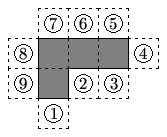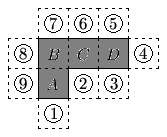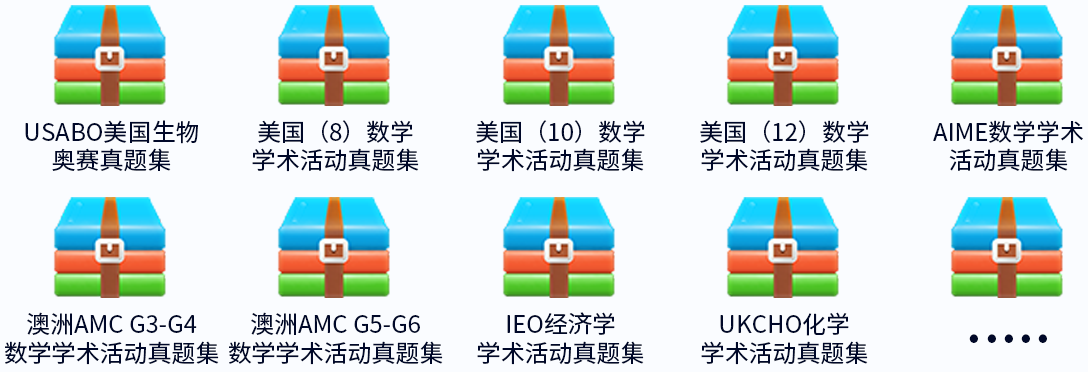- 翰林提供学术活动、国际课程、科研项目一站式留学背景提升服务!
- 400 888 0080
2003 AMC12A 真题及答案详细解析
2003 AMC 12A 真题
答案详细解析请参考文末
Problem 1
What is the difference between the sum of the first ![]() even counting numbers and the sum of the first
even counting numbers and the sum of the first ![]() odd counting numbers?
odd counting numbers? ![]()
Problem 2
Members of the Rockham Soccer League buy socks and T-shirts. Socks cost $4 per pair and each T-shirt costs $5 more than a pair of socks. Each member needs one pair of socks and a shirt for home games and another pair of socks and a shirt for away games. If the total cost is $2366, how many members are in the League? ![]()
Problem 3
A solid box is ![]() cm by
cm by ![]() cm by
cm by ![]() cm. A new solid is formed by removing a cube
cm. A new solid is formed by removing a cube ![]() cm on a side from each corner of this box. What percent of the original volume is removed?
cm on a side from each corner of this box. What percent of the original volume is removed? ![]()
Problem 4
It takes Mary ![]() minutes to walk uphill
minutes to walk uphill ![]() km from her home to school, but it takes her only
km from her home to school, but it takes her only ![]() minutes to walk from school to her home along the same route. What is her average speed, in km/hr, for the round trip?
minutes to walk from school to her home along the same route. What is her average speed, in km/hr, for the round trip? ![]()
Problem 5
The sum of the two 5-digit numbers ![]() and
and ![]() is
is ![]() . What is
. What is ![]() ?
? ![]()
Problem 6
Define ![]() to be
to be ![]() for all real numbers
for all real numbers ![]() and
and ![]() . Which of the following statements is not true?
. Which of the following statements is not true? ![]() for all
for all ![]() and
and ![]()
![]() for all
for all ![]() and
and ![]()
![]() for all
for all ![]()
![]() for all
for all ![]()
![]() if
if ![]()
Problem 7
How many non-congruent triangles with perimeter ![]() have integer side lengths?
have integer side lengths? ![]()
Problem 8
What is the probability that a randomly drawn positive factor of ![]() is less than
is less than ![]() ?
? ![]()
Problem 9
A set ![]() of points in the
of points in the ![]() -plane is symmetric about the origin, both coordinate axes, and the line
-plane is symmetric about the origin, both coordinate axes, and the line ![]() . If
. If ![]() is in
is in ![]() , what is the smallest number of points in
, what is the smallest number of points in ![]() ?
? ![]()
Problem 10
Al, Bert, and Carl are the winners of a school drawing for a pile of Halloween candy, which they are to divide in a ratio of ![]() , respectively. Due to some confusion they come at different times to claim their prizes, and each assumes he is the first to arrive. If each takes what he believes to be the correct share of candy, what fraction of the candy goes unclaimed?
, respectively. Due to some confusion they come at different times to claim their prizes, and each assumes he is the first to arrive. If each takes what he believes to be the correct share of candy, what fraction of the candy goes unclaimed? ![]()
Problem 11
A square and an equilateral triangle have the same perimeter. Let ![]() be the area of the circle circumscribed about the square and
be the area of the circle circumscribed about the square and ![]() the area of the circle circumscribed around the triangle. Find
the area of the circle circumscribed around the triangle. Find ![]() .
. ![]()
Problem 12
Sally has five red cards numbered ![]() through
through ![]() and four blue cards numbered
and four blue cards numbered ![]() through
through ![]() . She stacks the cards so that the colors alternate and so that the number on each red card divides evenly into the number on each neighboring blue card. What is the sum of the numbers on the middle three cards?
. She stacks the cards so that the colors alternate and so that the number on each red card divides evenly into the number on each neighboring blue card. What is the sum of the numbers on the middle three cards? ![]()
Problem 13
The polygon enclosed by the solid lines in the figure consists of 4 congruent squares joined edge-to-edge. One more congruent square is attached to an edge at one of the nine positions indicated. How many of the nine resulting polygons can be folded to form a cube with one face missing? 
![]()
Problem 14
Points ![]() and
and ![]() lie in the plane of the square
lie in the plane of the square ![]() such that
such that ![]() ,
, ![]() ,
, ![]() , and
, and ![]() are equilateral triangles. If
are equilateral triangles. If ![]() has an area of 16, find the area of
has an area of 16, find the area of ![]() .
. ![[asy] unitsize(2cm); defaultpen(fontsize(8)+linewidth(0.8)); pair A=(-0.5,0.5), B=(0.5,0.5), C=(0.5,-0.5), D=(-0.5,-0.5); pair K=(0,1.366), L=(1.366,0), M=(0,-1.366), N=(-1.366,0); draw(A--N--K--A--B--K--L--B--C--L--M--C--D--M--N--D--A); label("$A$",A,SE); label("$B$",B,SW); label("$C$",C,NW); label("$D$",D,NE); label("$K$",K,NNW); label("$L$",L,E); label("$M$",M,S); label("$N$",N,W); [/asy]](https://latex.artofproblemsolving.com/1/4/0/14057a8f4f08bad17471fdaed56a758f1e2fcea7.png)
![]()
Problem 15
A semicircle of diameter ![]() sits at the top of a semicircle of diameter
sits at the top of a semicircle of diameter ![]() , as shown. The shaded area inside the smaller semicircle and outside the larger semicircle is called a lune. Determine the area of this lune.
, as shown. The shaded area inside the smaller semicircle and outside the larger semicircle is called a lune. Determine the area of this lune. 
![]()
Problem 16
A point P is chosen at random in the interior of equilateral triangle ![]() . What is the probability that
. What is the probability that ![]() has a greater area than each of
has a greater area than each of ![]() and
and ![]() ?
? ![]()
Problem 17
Square ![]() has sides of length
has sides of length ![]() , and
, and ![]() is the midpoint of
is the midpoint of ![]() . A circle with radius
. A circle with radius ![]() and center
and center ![]() intersects a circle with radius
intersects a circle with radius ![]() and center
and center ![]() at points
at points ![]() and
and ![]() . What is the distance from
. What is the distance from ![]() to
to ![]() ?
? ![[asy] pair A,B,C,D,M,P; D=(0,0); C=(10,0); B=(10,10); A=(0,10); M=(5,0); P=(8,4); dot(M); dot(P); draw(A--B--C--D--cycle,linewidth(0.7)); draw((5,5)..D--C..cycle,linewidth(0.7)); draw((7.07,2.93)..B--A--D..cycle,linewidth(0.7)); label("$A$",A,NW); label("$B$",B,NE); label("$C$",C,SE); label("$D$",D,SW); label("$M$",M,S); label("$P$",P,N); [/asy]](https://latex.artofproblemsolving.com/b/1/f/b1f5dc5a294bcfb2e9f16e90d2d7b6f5843d52e1.png)
![]()
Problem 18
Let ![]() be a
be a ![]() -digit number, and let
-digit number, and let ![]() and
and ![]() be the quotient and the remainder, respectively, when
be the quotient and the remainder, respectively, when ![]() is divided by
is divided by ![]() . For how many values of
. For how many values of ![]() is
is ![]() divisible by
divisible by ![]() ?
? ![]()
Problem 19
A parabola with equation ![]() is reflected about the
is reflected about the ![]() -axis. The parabola and its reflection are translated horizontally five units in opposite directions to become the graphs of
-axis. The parabola and its reflection are translated horizontally five units in opposite directions to become the graphs of ![]() and
and ![]() , respectively. Which of the following describes the graph of
, respectively. Which of the following describes the graph of ![]() ?
? ![]()
![]()
![]()
Problem 20
How many ![]() -letter arrangements of
-letter arrangements of ![]() A's,
A's, ![]() B's, and
B's, and ![]() C's have no A's in the first
C's have no A's in the first ![]() letters, no B's in the next
letters, no B's in the next ![]() letters, and no C's in the last
letters, and no C's in the last ![]() letters?
letters? 
Problem 21
The graph of the polynomial ![]() has five distinct
has five distinct ![]() -intercepts, one of which is at
-intercepts, one of which is at ![]() . Which of the following coefficients cannot be zero?
. Which of the following coefficients cannot be zero? ![]()
Problem 22
Objects ![]() and
and ![]() move simultaneously in the coordinate plane via a sequence of steps, each of length one. Object
move simultaneously in the coordinate plane via a sequence of steps, each of length one. Object ![]() starts at
starts at ![]() and each of its steps is either right or up, both equally likely. Object
and each of its steps is either right or up, both equally likely. Object ![]() starts at
starts at ![]() and each of its steps is either to the left or down, both equally likely. Which of the following is closest to the probability that the objects meet?
and each of its steps is either to the left or down, both equally likely. Which of the following is closest to the probability that the objects meet? ![]()
Problem 23
How many perfect squares are divisors of the product ![]() ?
? ![]()
Problem 24
If ![]() what is the largest possible value of
what is the largest possible value of ![]()
![]()
Problem 25
Let ![]() . For how many real values of
. For how many real values of ![]() is there at least one positive value of
is there at least one positive value of ![]() for which the domain of
for which the domain of ![]() and the range of
and the range of ![]() are the same set?
are the same set? ![]() <hr />
<hr />
2003 AMC12 A 真题答案详细解析
- Solution 1 The first
 even counting numbers are
even counting numbers are  .
.
The first odd counting numbers are
odd counting numbers are  .
.
Thus, the problem is asking for the value of .
.
 Solution 2 Using the sum of an arithmetic progression formula, we can write this as
Solution 2 Using the sum of an arithmetic progression formula, we can write this as  . Solution 3 The formula for the sum of the first
. Solution 3 The formula for the sum of the first  even numbers, is
even numbers, is  , (E standing for even).
, (E standing for even).
Sum of first odd numbers, is
odd numbers, is  , (O standing for odd).
, (O standing for odd).
Knowing this, plug for
for  ,
, 
 .
. - Since T-shirts cost
 dollars more than a pair of socks, T-shirts cost
dollars more than a pair of socks, T-shirts cost  dollars.Since each member needs
dollars.Since each member needs  pairs of socks and
pairs of socks and  T-shirts, the total cost for
T-shirts, the total cost for  member is
member is  dollars.Since
dollars.Since  dollars was the cost for the club, and
dollars was the cost for the club, and  was the cost per member, the number of members in the League is
was the cost per member, the number of members in the League is  .
. - The volume of the original box is
 The volume of each cube that is removed is
The volume of each cube that is removed is  Since there are
Since there are  corners on the box,
corners on the box,  cubes are removed.So the total volume removed is
cubes are removed.So the total volume removed is  .Therefore, the desired percentage is
.Therefore, the desired percentage is 
-
Solution 1
Since she walked
 km to school and
km to school and  km back home, her total distance is
km back home, her total distance is  km.
km.
Since she spent minutes walking to school and
minutes walking to school and  minutes walking back home, her total time is
minutes walking back home, her total time is  minutes =
minutes =  hours.
hours.
Therefore her average speed in km/hr is .
.Solution 2
The average speed of two speeds that travel the same distance is the harmonic mean of the speeds, or
 (for speeds
(for speeds  and
and  ). Mary's speed going to school is
). Mary's speed going to school is  , and her speed coming back is
, and her speed coming back is  . Plugging the numbers in, we get that the average speed is
. Plugging the numbers in, we get that the average speed is  .
. 



 Since
Since  ,
,  , and
, and  are digits,
are digits,  ,
,  ,
,  .Therefore,
.Therefore,  .
.- Examining statement C:

 when
when  , but statement C says that it does for all
, but statement C says that it does for all  .Therefore the statement that is not true is
.Therefore the statement that is not true is 
- By the triangle inequality, no side may have a length greater than the semiperimeter, which is
 .Since all sides must be integers, the largest possible length of a side is
.Since all sides must be integers, the largest possible length of a side is  . Therefore, all such triangles must have all sides of length
. Therefore, all such triangles must have all sides of length  ,
,  , or
, or  . Since
. Since  , at least one side must have a length of
, at least one side must have a length of  . Thus, the remaining two sides have a combined length of
. Thus, the remaining two sides have a combined length of  . So, the remaining sides must be either
. So, the remaining sides must be either  and
and  or
or  and
and  . Therefore, the number of triangles is
. Therefore, the number of triangles is  .
. -
Solution 1
For a positive number
 which is not a perfect square, exactly half of the positive factors will be less than
which is not a perfect square, exactly half of the positive factors will be less than  .
.
Since is not a perfect square, half of the positive factors of
is not a perfect square, half of the positive factors of  will be less than
will be less than  .
.
Clearly, there are no positive factors of between
between  and
and  .
.
Therefore half of the positive factors will be less than .
.
So the answer is .
.Solution 2
Testing all numbers less than
 , numbers
, numbers  , and
, and  divide
divide  . The prime factorization of
. The prime factorization of  is
is  . Using the formula for the number of divisors, the total number of divisors of
. Using the formula for the number of divisors, the total number of divisors of  is
is  . Therefore, our desired probability is
. Therefore, our desired probability is 
- If
 is in
is in  , then
, then  is also, and quickly we see that every point of the form
is also, and quickly we see that every point of the form  or
or  must be in
must be in  . Now note that these
. Now note that these  points satisfy all of the symmetry conditions. Thus the answer is
points satisfy all of the symmetry conditions. Thus the answer is  .
. - Because the ratios are
 , Al, Bert, and Carl believe that they need to take
, Al, Bert, and Carl believe that they need to take  ,
,  , and
, and  of the pile when they each arrive, respectively. After each person comes,
of the pile when they each arrive, respectively. After each person comes,  ,
,  , and
, and  of the pile's size (just before each came) remains. The pile starts at
of the pile's size (just before each came) remains. The pile starts at  , and at the end
, and at the end  of the original pile goes unclaimed. (Note that because of the properties of multiplication, it does not matter what order the three come in.) Hence the answer is
of the original pile goes unclaimed. (Note that because of the properties of multiplication, it does not matter what order the three come in.) Hence the answer is  .
. - Suppose that the common perimeter is
 . Then, the side lengths of the square and triangle, respectively, are
. Then, the side lengths of the square and triangle, respectively, are  and
and  The circle circumscribed about the square has a diameter equal to the diagonal of the square, which is
The circle circumscribed about the square has a diameter equal to the diagonal of the square, which is  Therefore, the radius is
Therefore, the radius is  and the area of the circle is
and the area of the circle is  Now consider the circle circumscribed around the equilateral triangle. Due to symmetry, the circle must share a center with the equilateral triangle. The radius of the circle is simply the distance from the center of the triangle to a vertex. This distance is
Now consider the circle circumscribed around the equilateral triangle. Due to symmetry, the circle must share a center with the equilateral triangle. The radius of the circle is simply the distance from the center of the triangle to a vertex. This distance is  of an altitude. By
of an altitude. By  right triangle properties, the altitude is
right triangle properties, the altitude is  where s is the side. So, the radius is
where s is the side. So, the radius is  The area of the circle is
The area of the circle is  So,
So, 
- Let
 and
and  designate the red card numbered
designate the red card numbered  and the blue card numbered
and the blue card numbered  , respectively.
, respectively. is the only blue card that
is the only blue card that  evenly divides, so
evenly divides, so  must be at one end of the stack and
must be at one end of the stack and  must be the card next to it.
must be the card next to it. is the only other red card that evenly divides
is the only other red card that evenly divides  , so
, so  must be the other card next to
must be the other card next to  .
. is the only blue card that
is the only blue card that  evenly divides, so
evenly divides, so  must be at one end of the stack and
must be at one end of the stack and  must be the card next to it.
must be the card next to it. is the only other red card that evenly divides
is the only other red card that evenly divides  , so
, so  must be the other card next to
must be the other card next to  .
. doesn't evenly divide
doesn't evenly divide  , so
, so  must be next to
must be next to  ,
,  must be next to
must be next to  , and
, and  must be in the middle.This yields the following arrangement from top to bottom:
must be in the middle.This yields the following arrangement from top to bottom:  Therefore, the sum of the numbers on the middle three cards is
Therefore, the sum of the numbers on the middle three cards is  .
. -
Solution 1
 Let the squares be labeled
Let the squares be labeled  ,
,  ,
,  , and
, and  .
.
When the polygon is folded, the "right" edge of square becomes adjacent to the "bottom edge" of square
becomes adjacent to the "bottom edge" of square  , and the "bottom" edge of square
, and the "bottom" edge of square  becomes adjacent to the "bottom" edge of square
becomes adjacent to the "bottom" edge of square  .
.
So, any "new" square that is attatched to those edges will prevent the polygon from becoming a cube with one face missing.
Therefore, squares ,
,  , and
, and  will prevent the polygon from becoming a cube with one face missing.
will prevent the polygon from becoming a cube with one face missing.
Squares ,
,  ,
,  ,
,  ,
,  , and
, and  will allow the polygon to become a cube with one face missing when folded.
will allow the polygon to become a cube with one face missing when folded.
Thus the answer is .
.Solution 2
Another way to think of it is that a cube missing one face has
 of its
of its  faces. Since the shape has
faces. Since the shape has  faces already, we need another face. The only way to add another face is if the added square does not overlap any of the others.
faces already, we need another face. The only way to add another face is if the added square does not overlap any of the others.  ,
, , and
, and  overlap, while squares
overlap, while squares  to
to  do not. The answer is
do not. The answer is 
-
Solution 1
Since the area of square ABCD is 16, the side length must be 4. Thus, the side length of triangle AKB is 4, and the height of AKB, and thus DMC, is
 .
.
The diagonal of the square KNML will then be . From here there are 2 ways to proceed:
. From here there are 2 ways to proceed:
First: Since the diagonal is , the side length is
, the side length is  , and the area is thus
, and the area is thus  .
.
Second: Since a square is a rhombus, the area of the square is , where
, where  and
and  are the diagonals of the rhombus. Since the diagonal is
are the diagonals of the rhombus. Since the diagonal is  , the area is
, the area is  .
.Solution 2
Because
 has area
has area  , its side length is simply
, its side length is simply  .
.
Angle chasing, we find that the angle of .
.
We also know that .
.
Using Law of Cosines, we find that side .
.
However, the area of is simply
is simply  , hence the answer is
, hence the answer is  .
. ![[asy] import graph; size(150); defaultpen(fontsize(8)); pair A=(-2,0), B=(2,0); filldraw(Arc((0,sqrt(3)),1,0,180)--cycle,mediumgray); fill(Arc((0,0),2,0,180)--cycle,white); draw(Arc((0,0),2,0,180)--cycle); draw((0,0)--2*expi(2*pi/6)--2*expi(2*pi/6*2)--(0,0)); label("A",(0,2),(0,4)); label("B",(0,2),(0,-1)); label("C",(0,sqrt(3)/2),(0,2)); label("1",(-0.5,sqrt(3)/2),(-1,0)); label("1",(0.5,sqrt(3)/2),(1,0)); [/asy]](https://latex.artofproblemsolving.com/c/7/d/c7dc6582f0dd4a6d448e272a4a65408d00646000.png) Let
Let ![$[X]$](https://latex.artofproblemsolving.com/f/6/3/f631f7a53d834de52b718ed6b496689e9658eadf.png) denote the area of region
denote the area of region  in the figure above.The shaded area
in the figure above.The shaded area ![$[A]$](https://latex.artofproblemsolving.com/5/9/7/5974998abb6495b7e7cb9c32143687050121fe86.png) is equal to the area of the smaller semicircle
is equal to the area of the smaller semicircle ![$[A+B]$](https://latex.artofproblemsolving.com/a/e/1/ae1d8ff00ee5641906bcafa9a9ec1e98cb41498a.png) minus the area of a sector of the larger circle
minus the area of a sector of the larger circle ![$[B+C]$](https://latex.artofproblemsolving.com/d/7/7/d77dc2c402c80073c4eb779f64c4b3c5fbc1d9c1.png) plus the area of a triangle formed by two radii of the larger semicircle and the diameter of the smaller semicircle
plus the area of a triangle formed by two radii of the larger semicircle and the diameter of the smaller semicircle ![$[C]$](https://latex.artofproblemsolving.com/8/e/b/8eb0d5cccb9df6a659750553ad358f3f7c446956.png) .The area of the smaller semicircle is
.The area of the smaller semicircle is ![$[A+B] = frac{1}{2}picdotleft(frac{1}{2}right)^{2}=frac{1}{8}pi$](https://latex.artofproblemsolving.com/2/b/1/2b1643c5c18b6fa64bbd187553753154798d61c5.png) .Since the radius of the larger semicircle is equal to the diameter of the smaller semicircle, the triangle is an equilateral triangle and the sector measures
.Since the radius of the larger semicircle is equal to the diameter of the smaller semicircle, the triangle is an equilateral triangle and the sector measures  .The area of the
.The area of the  sector of the larger semicircle is
sector of the larger semicircle is ![$[B+C] = frac{60}{360}picdotleft(frac{2}{2}right)^{2}=frac{1}{6}pi$](https://latex.artofproblemsolving.com/b/c/8/bc879f9abc0c3162da87a9924837e849fe35b677.png) .The area of the triangle is
.The area of the triangle is ![$[C] = frac{1^{2}sqrt{3}}{4}=frac{sqrt{3}}{4}$](https://latex.artofproblemsolving.com/1/e/3/1e3b9d2aae4c54ac73fe5f02af335976a89ee9db.png) .So the shaded area is
.So the shaded area is ![$[A] = [A+B]-[B+C]+[C] = left(frac{1}{8}piright)-left(frac{1}{6}piright)+left(frac{sqrt{3}}{4}right)=boxed{mathrm{(C)} frac{sqrt{3}}{4}-frac{1}{24}pi}$](https://latex.artofproblemsolving.com/8/5/1/851075ddcae6c08caa75052db7fd1cbfec7b9ca9.png) .
.![[asy] draw((0,10)--(8.660254037844385792,-5)--(-8.660254037844385792,-5)--cycle); dot((0,0)); label("$P$",(0,0),N); [/asy]](https://latex.artofproblemsolving.com/7/3/1/7317615fe926227cc67fff473db1007fdca5896a.png)
Solution 1
After we pick point
 , we realize that
, we realize that  is symmetric for this purpose, and so the probability that
is symmetric for this purpose, and so the probability that  is the greatest area, or
is the greatest area, or  or
or  , are all the same. Since they add to
, are all the same. Since they add to  , the probability that
, the probability that  has the greatest area is
has the greatest area is 
Solution 2
We will use geometric probability. Let us take point
 , and draw the perpendiculars to
, and draw the perpendiculars to  ,
,  , and
, and  , and call the feet of these perpendiculars
, and call the feet of these perpendiculars  ,
,  , and
, and  respectively. The area of
respectively. The area of  is simply
is simply  . Similarly we can find the area of triangles
. Similarly we can find the area of triangles  and
and  . If we add these up and realize that it equals the area of the entire triangle, we see that no matter where we choose
. If we add these up and realize that it equals the area of the entire triangle, we see that no matter where we choose  = the height of the triangle. Setting the area of triangle
= the height of the triangle. Setting the area of triangle  greater than
greater than  and
and  , we want
, we want  to be the largest of
to be the largest of  ,
,  , and
, and  . We then realize that
. We then realize that  when
when  is the in center of
is the in center of  . Let us call the in center of the triangle
. Let us call the in center of the triangle  . If we want
. If we want  to be the largest of the three, by testing points we realize that
to be the largest of the three, by testing points we realize that  must be in the interior of quadrilateral
must be in the interior of quadrilateral  . So our probability (using geometric probability) is the area of
. So our probability (using geometric probability) is the area of  divided by the area of
divided by the area of  . We will now show that the three quadrilaterals,
. We will now show that the three quadrilaterals,  ,
,  , and
, and  are congruent. As the definition of point
are congruent. As the definition of point  yields,
yields,  =
=  =
=  . Since
. Since  is equilateral,
is equilateral,  is also the circum center of
is also the circum center of  , so
, so  . By the Pythagorean Theorem,
. By the Pythagorean Theorem,  . Also, angles
. Also, angles  , and
, and  are all equal to
are all equal to  . Angles
. Angles  are all equal to
are all equal to  degrees, so it is now clear that quadrilaterals
degrees, so it is now clear that quadrilaterals  are all congruent. Summing up these areas gives us the area of
are all congruent. Summing up these areas gives us the area of  .
.  contributes to a third of that area so
contributes to a third of that area so ![$frac{[QDCE]}{[ABC]}=boxed{mathrm{(C)} dfrac{1}{3}}$](https://latex.artofproblemsolving.com/6/2/6/626c91e1d58db28da0bb6b7b237827d447598e9e.png) .
.-
Solution 1
Let
 be the origin.
be the origin.  is the point
is the point  and
and  is the point
is the point  . We are given the radius of the quarter circle and semicircle as
. We are given the radius of the quarter circle and semicircle as  and
and  , respectively, so their equations, respectively, are:
, respectively, so their equations, respectively, are: 
 Subtract the second equation from the first:
Subtract the second equation from the first: 

 Then substitute:
Then substitute: 


 Thus
Thus  and
and  making
making  and
and  .
.
The first value of is obviously referring to the x-coordinate of the point where the circles intersect at the origin,
is obviously referring to the x-coordinate of the point where the circles intersect at the origin,  , so the second value must be referring to the x coordinate of
, so the second value must be referring to the x coordinate of  . Since
. Since  is the y-axis, the distance to it from
is the y-axis, the distance to it from  is the same as the x-value of the coordinate of
is the same as the x-value of the coordinate of  , so the distance from
, so the distance from  to
to  is
is 
Solution 2
 obviously forms a kite. Let the intersection of the diagonals be
obviously forms a kite. Let the intersection of the diagonals be  .
.  Let
Let  . Then,
. Then,  .
.
By Pythagorean Theorem, . Thus,
. Thus,  . Simplifying,
. Simplifying,  . By Pythagoras again,
. By Pythagoras again,  . Then, the area of
. Then, the area of  is
is  .
.
Using instead as the base, we can drop a altitude from P.
instead as the base, we can drop a altitude from P.  .
.  . Thus, the horizontal distance is
. Thus, the horizontal distance is 
-
Solution 1
When a
 -digit number is divided by
-digit number is divided by  , the first
, the first  digits become the quotient,
digits become the quotient,  , and the last
, and the last  digits become the remainder,
digits become the remainder,  .
.
Therefore, can be any integer from
can be any integer from  to
to  inclusive, and
inclusive, and  can be any integer from
can be any integer from  to
to  inclusive.
inclusive.
For each of the possible values of
possible values of  , there are at least
, there are at least  possible values of
possible values of  such that
such that  .
.
Since there is "extra" possible value of
"extra" possible value of  that is congruent to
that is congruent to  , each of the
, each of the  values of
values of  that are congruent to
that are congruent to  have
have  more possible value of
more possible value of  such that
such that  .
.
Therefore, the number of possible values of such that
such that  is
is  .
.Solution 2
Notice that
 . This means that any number whose quotient and remainder sum is divisible by 11 must also be divisible by 11. Therefore, there are
. This means that any number whose quotient and remainder sum is divisible by 11 must also be divisible by 11. Therefore, there are  possible values. The answer is
possible values. The answer is  .
.Solution 3
Let
 be the five digits of
be the five digits of  . Then
. Then  and
and  . By the divisibility rules of
. By the divisibility rules of  ,
,  and
and  , so
, so  . Thus,
. Thus,  must be divisble by
must be divisble by  . There are
. There are  five-digit multiples of
five-digit multiples of  , so the answer is
, so the answer is  .
. -
Solution 1
If we take the parabola
 and reflect it over the x - axis, we have the parabola
and reflect it over the x - axis, we have the parabola  . Without loss of generality, let us say that the parabola is translated 5 units to the left, and the reflection to the right. Then:
. Without loss of generality, let us say that the parabola is translated 5 units to the left, and the reflection to the right. Then:  Adding them up produces:
Adding them up produces: This is a line with slope
This is a line with slope  . Since
. Since  cannot be
cannot be  (because
(because  would be a line) we end up with
would be a line) we end up with 
Solution 2: less computation
WLOG let the parabola be
 , and the reflected parabola is thus
, and the reflected parabola is thus  . We can also assume
. We can also assume![[f(x) = (x+5)^2 = x^2 + 10x + 25]](https://latex.artofproblemsolving.com/2/4/8/248146c0dd9a04f5f7c7c130a5fd4108deaa57f1.png) and
and![[g(x) = -(x-5)^2 = -x^2 + 10x - 25.]](https://latex.artofproblemsolving.com/f/f/1/ff19b0b1afe1b23a2f745434d4384278233d7a69.png) Therefore,
Therefore,![[(f+g)(x) = x^2 + 10x + 25 - x^2 + 10x - 25 = 20x,]](https://latex.artofproblemsolving.com/b/8/9/b8923b792dd06eee2d789704e72df43820054403.png) which is a non-horizontal line
which is a non-horizontal line  .
. - The answer is
 .Note that the first five letters must be B's or C's, the next five letters must be C's or A's, and the last five letters must be A's or B's. If there are
.Note that the first five letters must be B's or C's, the next five letters must be C's or A's, and the last five letters must be A's or B's. If there are  B's in the first five letters, then there must be
B's in the first five letters, then there must be  C's in the first five letters, so there must be
C's in the first five letters, so there must be  C's and
C's and  A's in the next five letters, and
A's in the next five letters, and  A's and
A's and  B's in the last five letters. Therefore the number of each letter in each group of five is determined completely by the number of B's in the first 5 letters, and the number of ways to arrange these 15 letters with this restriction is
B's in the last five letters. Therefore the number of each letter in each group of five is determined completely by the number of B's in the first 5 letters, and the number of ways to arrange these 15 letters with this restriction is  (since there are
(since there are  ways to arrange
ways to arrange  B's and
B's and  C's). Therefore the answer is
C's). Therefore the answer is  .
. -
Solution 1
Let the roots be
 . According to Vieta's formulas, we have
. According to Vieta's formulas, we have  . The first four terms contain
. The first four terms contain  and are therefore zero, thus
and are therefore zero, thus  . This is a product of four non-zero numbers, therefore
. This is a product of four non-zero numbers, therefore  must be non-zero
must be non-zero  .
.Solution 2
Clearly, since
 is an intercept,
is an intercept,  must be
must be  . But if
. But if  was
was  ,
,  would divide the polynomial, which means it would have a double root at
would divide the polynomial, which means it would have a double root at  , which is impossible, since all five roots are distinct.
, which is impossible, since all five roots are distinct. - If
 and
and  meet, their paths connect
meet, their paths connect  and
and  There are
There are  such paths. Since the path is
such paths. Since the path is  units long, they must meet after each travels
units long, they must meet after each travels  units, so the probability is
units, so the probability is  .
. -
Solution 1
We want to find the number of perfect square factors in the product of all the factorials of numbers from
 . We can write this out and take out the factorials, and then find a prime factorization of the entire product. We can also find this prime factorization by finding the number of times each factor is repeated in each factorial. This comes out to be equal to
. We can write this out and take out the factorials, and then find a prime factorization of the entire product. We can also find this prime factorization by finding the number of times each factor is repeated in each factorial. This comes out to be equal to 





 . To find the amount of perfect square factors, we realize that each exponent in the prime factorization must be even:
. To find the amount of perfect square factors, we realize that each exponent in the prime factorization must be even: 





 . To find the total number of possibilities, we add
. To find the total number of possibilities, we add  to each exponent and multiply them all together. This gives us
to each exponent and multiply them all together. This gives us 


 .
.Solution 2
( Just Explanation Of 1 )
We can easily find that factorials upto 9 in product lead to prime factorization





 So number of pairs possible = {
So number of pairs possible = { 


 ...
...  }{
}{ 


 ...
...  }{
}{ 


 ...
...  }{
}{ 

 }
}
Which leads to resulting number of pairs =


 .
. - Using logarithmic rules, we see that
![[log_{a}a-log_{a}b+log_{b}b-log_{b}a = 2-(log_{a}b+log_{b}a)]](https://latex.artofproblemsolving.com/a/c/8/ac81a63197833883d0f23b2c94e96af4303e9c3e.png)
![[=2-(log_{a}b+frac {1}{log_{a}b})]](https://latex.artofproblemsolving.com/8/6/9/86936dda057f6fa26fa792fcec247eb7fd350936.png) Since
Since  and
and  are both positive, using AM-GM gives that the term in parentheses must be at least
are both positive, using AM-GM gives that the term in parentheses must be at least  , so the largest possible values is
, so the largest possible values is  Note that the maximum occurs when
Note that the maximum occurs when  .
. -
Solution 1
The function
 has a codomain of all non-negative numbers, or
has a codomain of all non-negative numbers, or  . Since the domain and the range of
. Since the domain and the range of  are the same, it follows that the domain of
are the same, it follows that the domain of  also satisfies
also satisfies  .
.
The function has two zeroes at , which must be part of the domain. Since the domain and the range are the same set, it follows that
, which must be part of the domain. Since the domain and the range are the same set, it follows that  is in the codomain of
is in the codomain of  , or
, or  . This implies that one (but not both) of
. This implies that one (but not both) of  is non-positive. The problem states that there is at least one positive value of b that works, thus
is non-positive. The problem states that there is at least one positive value of b that works, thus  must be non-positive,
must be non-positive,  is non-negative, and the domain of the function occurs when
is non-negative, and the domain of the function occurs when  , or
, or Completing the square,
Completing the square,  by the Trivial Inequality (remember that
by the Trivial Inequality (remember that  ). Since
). Since  is continuous and assumes this maximal value at
is continuous and assumes this maximal value at  , it follows that the range of
, it follows that the range of  is
is As the domain and the range are the same, we have that
As the domain and the range are the same, we have that  (we can divide through by
(we can divide through by  since it is given that
since it is given that  is positive). Hence
is positive). Hence  , which both we can verify work, and the answer is
, which both we can verify work, and the answer is  .
.Solution 2
If
 , then squaring both sides of the given equation and subtracting
, then squaring both sides of the given equation and subtracting  and
and  yields
yields  . Completing the square, we get
. Completing the square, we get  where
where  . Divide out by
. Divide out by  to put the equation in the standard form of an ellipse or hyperbola (depending on the sign of
to put the equation in the standard form of an ellipse or hyperbola (depending on the sign of  ) to get
) to get  .
.
Before continuing, it is important to note that because ,
,  has roots 0 and
has roots 0 and  . Now, we can use the function we deduced to figure out some of its properties when:
. Now, we can use the function we deduced to figure out some of its properties when:  : A semi-hyperbola above or on the x-axis. Therefore, no positive value of
: A semi-hyperbola above or on the x-axis. Therefore, no positive value of  allows the domain and range to be the same set because the range will always be
allows the domain and range to be the same set because the range will always be  and the domain will always be undefined on some finite range between some value and zero.
and the domain will always be undefined on some finite range between some value and zero.  : We must refer back to the original function; this results in a horizontal semiparabola in the first quadrant, which satisfies that the domain and range of the function are equal. Specifically, both sets are
: We must refer back to the original function; this results in a horizontal semiparabola in the first quadrant, which satisfies that the domain and range of the function are equal. Specifically, both sets are  .
.  is the only case where this happens.
is the only case where this happens.  : A semi-ellipse in quadrant one. Since its roots are 0 and
: A semi-ellipse in quadrant one. Since its roots are 0 and  , its domain must be
, its domain must be ![$[0, -frac{b}{a}]$](https://latex.artofproblemsolving.com/c/f/9/cf9cf7ad21f3a3271e986abc4f353a34c397cb00.png) . To make its domain and range equal, the maximum value of the ellipse must then be
. To make its domain and range equal, the maximum value of the ellipse must then be  . But we have another expression for the maximum value of the ellipse, which is
. But we have another expression for the maximum value of the ellipse, which is  . Setting these two expressions equal to each other will find us the final value of
. Setting these two expressions equal to each other will find us the final value of  that satisfies the question.
that satisfies the question. 


 We already knew 0 was a solution from earlier, so -4 is our only new solution (we already ruled out any positive value of
We already knew 0 was a solution from earlier, so -4 is our only new solution (we already ruled out any positive value of  as a solution, so 4 does not work). Thus there are
as a solution, so 4 does not work). Thus there are  values of
values of  that make the domain and range of
that make the domain and range of  the same set.
the same set.
以上解析方式仅供参考
学术活动报名扫码了解!免费领取历年真题!

最新发布
© 2025. All Rights Reserved. 沪ICP备2023009024号-1









